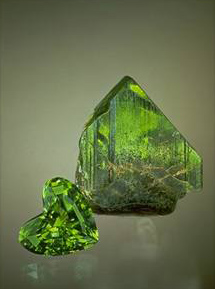|
Cheralite
Cheralite is an anhydrous phosphate mineral with the ideal chemical formula CaTh(PO4)2. It is isomorphous with huttonite Huttonite is a thorium nesosilicate mineral with the chemical formula and which crystallizes in the monoclinic system. It is dimorphous with tetragonal thorite, and isostructual with monazite. An uncommon mineral, huttonite forms transparent or ... and monazite. It can be regarded as the product of the complete cationic substitution in the system: 2 LREE3+ ↔ Ca2+ + Th4+. It was previously known under the name brabantite. Physical properties: {, class="wikitable" , + !Property !Value , - , Lustre , Vitreous , - , Description , Dull or greasy , - , Colour , Grayish brown to reddish brown (on rims), pale yellow, brownish green , - , Hardness , 5 on Mohs scale , - , Density , 4.72 - 5.02 g/cm3 References Thorium minerals Phosphate minerals ... [...More Info...] [...Related Items...] OR: [Wikipedia] [Google] [Baidu] |
Phosphate Mineral
Phosphate minerals contain the tetrahedrally coordinated phosphate (PO43−) anion along sometimes with arsenate (AsO43−) and vanadate (VO43−) substitutions, and chloride (Cl−), fluoride (F−), and hydroxide (OH−) anions that also fit into the crystal structure. The phosphate class of minerals is a large and diverse group, however, only a few species are relatively common. Applications Phosphate rock has high concentration of phosphate minerals, most commonly of the apatite group. It is the major resource mined to produce phosphate fertilizers for the agriculture sector. Phosphate is also used in animal feed supplements, food preservatives, anti-corrosion agents, cosmetics, fungicides, ceramics, water treatment and metallurgy. The largest use of minerals mined for their phosphate content is the production of fertilizer. Phosphate minerals are often used for control of rust and prevention of corrosion on ferrous materials applied with electrochemical conversion co ... [...More Info...] [...Related Items...] OR: [Wikipedia] [Google] [Baidu] |
Isomorphism (crystallography)
In chemistry isomorphism has meanings both at the level of crystallography and at a molecular level. In crystallography, compounds are isomorphous if their symmetry is the same and their unit cell parameters are similar Molecules are isomorphous if they have similar shapes. The coordination complexes tris(acetylacetonato)iron (Fe(acac)3) and tris(acetylacetonato)aluminium (Al(acac)3) are isomorphous. These compounds, both of ''D''3 symmetry have very similar shapes, as determined by bond lengths and bond angles. Isomorphous compounds give rise to isomorphous crystals and form solid solutions. Historically, crystal shape was defined by measuring the angles between crystal faces with a goniometer. Whereas crystals of Fe(acac)3 are deep red and crystals of Al(acac)3 are colorless, a solid solution of the two, i.e. Fe1−xAlx(acac)3 will be deep or pale pink depending on the Fe/Al ratio, x. Double sulfates, such as Tutton's salt, with the generic formula MI2MII(SO4)2.6H2O, wh ... [...More Info...] [...Related Items...] OR: [Wikipedia] [Google] [Baidu] |
Huttonite
Huttonite is a thorium nesosilicate mineral with the chemical formula and which crystallizes in the monoclinic system. It is dimorphous with tetragonal thorite, and isostructual with monazite. An uncommon mineral, huttonite forms transparent or translucent cream–colored crystals. It was first identified in samples of beach sands from the West Coast region of New Zealand by the mineralogist Colin Osborne Hutton (1910–1971). Owing to its rarity, huttonite is not an industrially useful mineral. Occurrence Huttonite was first described in 1950 from beach sand and fluvio-glacial deposits in South Westland, New Zealand, where it was found as anhedral grains of no more than 0.2 mm maximum dimension. It is most prevalent in the sand at Gillespie's Beach, near Fox Glacier, which is the type location, where it is accompanied by scheelite, cassiterite, zircon, uranothorite, ilmenite and gold. It was found at a further six nearby locations in less plentiful amounts. Hutt ... [...More Info...] [...Related Items...] OR: [Wikipedia] [Google] [Baidu] |
Monazite
Monazite is a primarily reddish-brown phosphate mineral that contains rare-earth elements. Due to variability in composition, monazite is considered a group of minerals. The most common species of the group is monazite-(Ce), that is, the cerium-dominant member of the group. It occurs usually in small isolated crystals. It has a hardness of 5.0 to 5.5 on the Mohs scale of mineral hardness and is relatively dense, about 4.6 to 5.7 g/cm3. There are five different most common species of monazite, depending on the relative amounts of the rare earth elements in the mineral: * monazite-(Ce), ( Ce, La, Nd, Th) PO4 (the most common member), * monazite-(La), (La,Ce,Nd)PO4, * monazite-(Nd), (Nd,La,Ce)PO4, * monazite-(Sm), ( Sm, Gd,Ce,Th)PO4, * monazite-(Pr), ( Pr,Ce,Nd,Th)PO4. The elements in parentheses are listed in the order of their relative proportion within the mineral: lanthanum is the most common rare-earth element in monazite-(La), and so forth. Silica (SiO2) is present in trace a ... [...More Info...] [...Related Items...] OR: [Wikipedia] [Google] [Baidu] |
Thorium Minerals
Thorium is a weakly radioactive metallic chemical element with the symbol Th and atomic number 90. Thorium is silvery and tarnishes black when it is exposed to air, forming thorium dioxide; it is moderately soft and malleable and has a high melting point. Thorium is an electropositive actinide whose chemistry is dominated by the +4 oxidation state; it is quite reactive and can ignite in air when finely divided. All known thorium isotopes are unstable. The most stable isotope, 232Th, has a half-life of 14.05 billion years, or about the age of the universe; it decays very slowly via alpha decay, starting a decay chain named the thorium series that ends at stable 208 Pb. On Earth, thorium and uranium are the only significantly radioactive elements that still occur naturally in large quantities as primordial elements. Thorium is estimated to be over three times as abundant as uranium in the Earth's crust, and is chiefly refined from monazite sands as a by-product of extractin ... [...More Info...] [...Related Items...] OR: [Wikipedia] [Google] [Baidu] |


